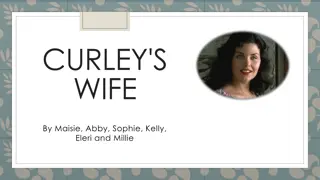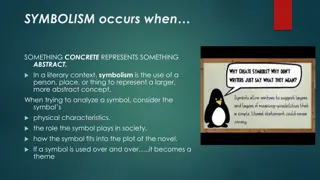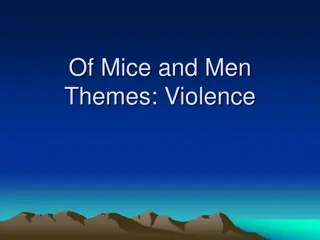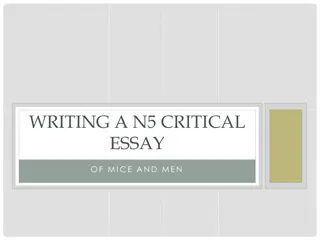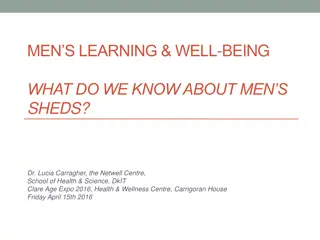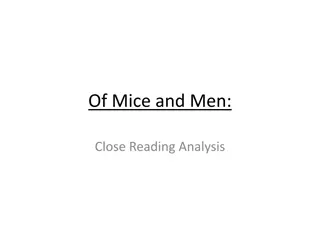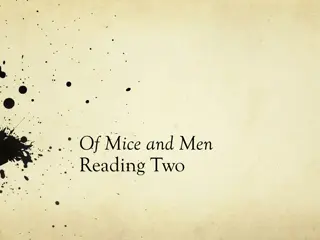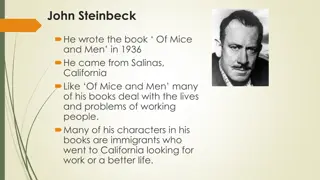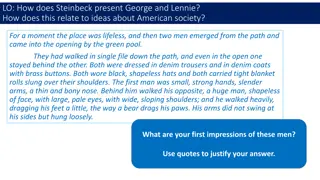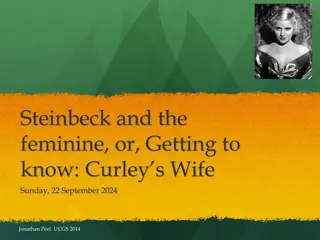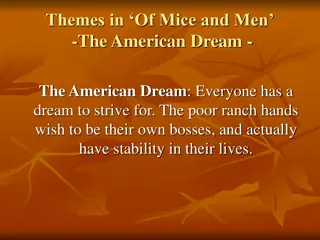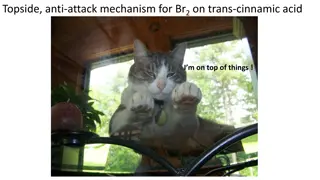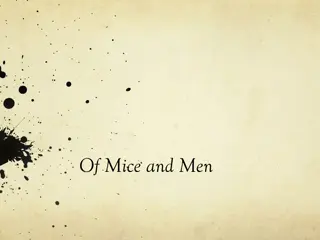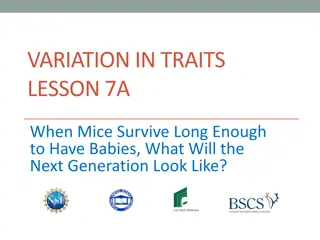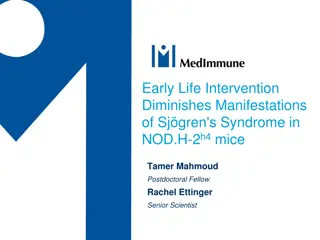Understanding Key Events in "Of Mice and Men": Curley's Attack on Lennie
In Chapter Three of "Of Mice and Men," Curley's attack on Lennie is a key incident that reveals the brutal nature of Curley and the immense strength and vulnerability of Lennie. The event not only showcases effective characterisation but also evokes sympathy for Lennie while foreshadowing the consequences of his actions. Through examining this key event, readers gain deeper insights into the characters and themes of the novel.
Download Presentation

Please find below an Image/Link to download the presentation.
The content on the website is provided AS IS for your information and personal use only. It may not be sold, licensed, or shared on other websites without obtaining consent from the author. Download presentation by click this link. If you encounter any issues during the download, it is possible that the publisher has removed the file from their server.
E N D
Presentation Transcript
Of Mice and Men Key Events
Learning intentions and success criteria Through this presentation, you will learn about key events in a novel-how to define key events. What the key events are in Of Mice and Men by John Steinbeck. What we learn through these key events about characters, themes and the structure of the novel. You will be successful if you can then show your understanding of: how to define a key event what the key events are in Of Mice and Men and what we learn from them AND can use that knowledge and understanding effectively when writing a critical essay
What is a key event in a novel? A key event/ key incident is one which: Allows the reader to learn more about a character OR Is important to the structure of the novel OR Moves the plot on in some way OR Helps to convey a theme OR A combination of any of the above
What are the key incidents in Of Mice and Men Chapter Three- Curley attacks Lennie Chapter Four- Crooks room Chapter Five- the death of Curley s wife Chapter Six- George shoots Lennie
Chapter Three- Curleys attack on Lennie Why is this a key incident? Because it shows us how brutal the character of Curley is. (Effective characterisation) He has no reason to dislike Lennie- he just hates big guys because he is so small. He attacks Lennie because he feels humiliated by the other men, and thinks that Lennie is laughing at him. He has accused Slim of being with his wife, but backs down when Slim is angry. The other men are delighted; Carlson calls Curley Yella as a frog belly . Curley brutally attacks Lennie. Look at the language. Curley is balanced and poised . He slashed at Lennie with his left and then smashed down his nose with a right . He was slugging him in the face and then attacked his stomach and cut off his wind
Chapter Three- Curleys attack on Lennie continued. This is also a key incident because it : Creates great sympathy for Lennie, but also shows what Lennie is capable of because of his great strength. ( effective characterisation and foreshadowing) Lennie is terrified: Lennie gave a cry of terror George he cried make um let me alone. George. Lennie covered his face with his huge paws and bleated with terror. He cried Make um stop George . He relies on George to make things all right for him. He only hurts Curley once George tells him to. What happens next is not his fault.
Chapter Three- Curleys attack on Lennie continued We see what Lennie is capable of: Curley s fist was swinging when Lennie reached for it. The next minute Curley was flopping like a fish on a line, and his closed fist was lost in Lennie s big hand. George shouts at Lennie to let go but Lennie watched in terror the flopping little man whom he held George slapped him on the face again and again, and still Lennie held on to the closed fist. Lennie completely crushes Curley s hand- evidence of his huge strength, Lennie would not let go- evidence of his behaviour when he is scared. (Links back to the incident in Weed when he held on to the girl s dress.) The climax, when Lennie kills Curley s wife is being foreshadowed here. This incident makes Curley hate Lennie, and causes his wish to kill Lennie after Lennie kills his wife. He wants revenge. This is one of the reasons why George had to shoot Lennie himself.
Chapter Four- Crooks room This is a key event because: It introduces us properly to the character of Crooks, which allows Steinbeck to portray the racial inequality which existed at that time. ( Effective characterisation) It conveys the theme of loneliness through the characters of Crooks and Curley s wife. It conveys the theme of a dream of a better life.
Crooks Crooks is lonely and isolated. We know this because: He complains to Lennie that he is not allowed in the bunkhouse because he is black. The other (white) men say that he stinks . He says that no one pays any attention to what he says because It s just a nigger saying it. He is jealous of Lennie and George s friendship and tries to upset Lennie. He is the only coloured man on the ranch and there is only one coloured family in Soledad. He allows Lennie, and then Candy into his room, and is quite pleased even though he tries to hide it. He offers to come and work on their little farm- for nothing.
Theme of Loneliness We have already seen how this is conveyed through Crooks. But who else is lonely? Curley s wife is lonely. When Candy tells her she should go home she says: Think I don t like to talk to somebody every once in a while? Think I like to stick in that house alla time? ( this is also effective characterisation because it helps us to understand her behaviour. She is not really chasing after/ flirting with the men- she wants company.) She is alone on a Saturday night- even Curley has gone to the cat house, and she has no-one else to talk to: An what am I doing? Standing here talking to a bunch of bindle stiffs- a nigger an a dum dum an a lousy old sheep- an liking it because they ain t nobody else.
Theme of a dream of a better life Lennie and Candy both defend their dream of owning their own land, to Crooks, who is initially cynical, but then wants to be part of it. He says he has seen hundreds of men with the same dream but: Nobody never gets no land. It s just in their head. When he realises it may be possible he then wants to go with them. Candy also defends the dream to Curley s wife, who is also very cynical: Candy- You don t know that we got our own ranch to go to. We ain t gotta stay here. We gotta house, an chickens, an fruit trees ..an we got frens . Her response is Baloney.. I seen too many of you guys .
Theme of a dream of a better life Candy explains the importance of the dream: Sure they all want it. Everybody wants a little bit of land, not much. Just som thin that was his. Som thin he could live on and there couldn t nobody throw him off it. I planted crops for damn near everybody in this state, but they wasn t my crops. What men like George, Lennie and Candy want is something and somewhere that belongs to them. Somewhere that their hard work will result in benefit to them. They also want the freedom. Steinbeck is portraying the harsh reality for itinerant workers of the time- they owned nothing, they did not belong anywhere and they had no security- hence they all had the same dream.
Crooks dream, and Curleys wifes dream. Crooks had a happy childhood living on his family farm. He had a family, and brothers he was close to. He had white friends too. Now he is totally isolated. All he wants is to be treated like an equal, and to have some company. That is why he jumps at the chance to join George, Lennie and Candy. The incident with Curley s wife however shows that he will never achieve his dream. Curley s wife talks about how she could have went with shows , and been in pitchers . She thinks she could have been famous instead of being stuck on the ranch with no one to talk to except Curley.
Racial inequality We have already seen how Crooks is isolated because of his colour, and how he is treated very badly by the white men. In Chapter Four, through the behaviour of Curley s wife, we also see just how precarious his position is. When Crooks speaks sharply to Curley s wife and threatens to tell the boss she has been in his room, she turns on him. Listen nigger she said, You know what I can do to you if you open your trap. I could get you strung up on a tree so easy it ain t even funny She knows that she holds all the power, and one word from her could get him lynched. Crooks immediately retreats into himself: Crooks had reduced himself to nothing. Steinbeck wants the reader to be shocked by the terrible reality of Crooks situation.
Chapter Five- the Death of Curleys wife This is a key event because: It is the climax of the novel and leads to the resolution- George has to shoot Lennie. ( plot structure) The reader learns more about Curley s wife and sympathy for her is created (effective characterisation) The reader learns more about Lennie ( effective characterisation) It is the end of the dream for George and Lennie. (Theme)
The climax This event has been foreshadowed throughout the novel. Lennie accidentally killing mice; the incident in Weed; crushing Curley s hand; killing the puppy; all of this has built up to the killing of Curley s wife.
Effective characterisation of Curleys wife Up until this point Curley s wife has been portrayed in a bad light. She has been described ( by the ranch hands) as a tart , jail bait that bitch ; that she is giving the men the eye . The way that she dresses, and her mannerisms all back this up. However we now find out that she is just a young girl who has acted foolishly, rushing into marriage with Curley to spite her mother. She has had a dream of a better life(theme)- she wanted to be in shows or pitchers - to be famous and wear nice clothes. She thinks her mother stole the letter from the man from Hollywood. She says I wasn t gonna stay no place where I couldn t get nowhere or make something of myself. Yet look at where she has ended up.
Effective characterisation of Curleys wife She is lonely, and only wants someone talk to: Why can t I talk to you? I never get to talk to nobody. I get awful lonely (Theme of loneliness and isolation.) She does not really see Lennie as a threat. She thinks he is just like a big baby. Her loneliness leads to her death. Once she is dead, she is described in a very different way, and we can see her as the young girl that she is. And the meanness and the plannings and the discontent were gone from her face. She was very pretty and simple, and her face was sweet and young. We have never known her name. That seems sad.
Effective characterisation of Lennie Lennie has killed the puppy, but does not really understand that it was his fault. Why do you got to get killed? and I didn t know you d get killed so easy. He is only worried about George being angry and not letting him tend the rabbits. This shows that Lennie never learns from previous experiences.. When he is stroking her hair and she shouts at him to stop he panics, and holds on. He the accidentally breaks her neck when he is trying to stop her screaming. This shows us his immense strength, and how dangerous he can actually be when he is angry. He does not understand the enormity of what he has done. To him it is just a real bad thing . He takes the puppy away- this shows his innocence- he makes no attempt to hide her body.
The end of the dream for George and Lennie. Candy is still keen to pursue the dream of the little farm with George, but for George this is the end. I think I knowed. I think I knowed from the very first we d never do her. He usta like to hear about it so much I got to thinking maybe we would. George will now become like all the other guys. (Theme of loneliness and isolation.) I ll work my month and I ll take my fifty bucks an I ll stay all night in some lousy cat house ..An then I ll come back and work another month an I ll have fifty bucks more
The resolution- George shoots Lennie This is a key event because: It is the resolution of the novel, meaning the only possible outcome of all the previous events. (Plot structure) It conveys the theme of loneliness It shows the true friendship that George had for Lennie (effective characterisation.)
The resolution- George shoots Lennie George realises that he has no choice but to kill Lennie: He thinks maybe they could bring Lennie in to be locked up, but Slim disagrees. Curley s gonna want to shoot him. Curley s still mad about his hand. An s pose they lock him up an strap him down and put him in a cage? That ain t no good George George has stolen Carlson s gun, but the men think Lennie has it- making them more determined to shoot him. Curley wants revenge. I m gonna shoot the guts out of that big bastard myself..
Georges act of friendship. George tries to make Lennie think everything is normal. He tries to give him hell , but he can t. He tells Lennie about how they are different from the other guys. He makes sure that Lennie is happy when he dies, and has no fear. He tells him to look off into the distance, and then when he is describing the little farm that they will have, he shoots him. ( In the back of the head- instant death.) He makes sure that Lennie knows he is not mad at him. No Lennie, I ain t mad. I never been mad an I ain t now. That s a thing I want you to know. All of this shows us how much George cares for Lennie, and that he is a true friend- protecting him till the end.
Theme of loneliness George will now be just like all the other men, and his dream is over. No one except Slim understands what George did, and why he had to do it. No one will understand how George feels now, and what a great loss it is to him.






